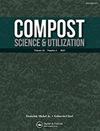Use of Organic Compost for the Fertilization of Piatã and Paiaguás Grasses: Effects of Dose on Morphogenetic, Structural, Nutritional, and Productive Characteristics
IF 0.9
4区 农林科学
Q3 ECOLOGY
引用次数: 5
Abstract
ABSTRACT The use of organic compost in pasture fertilization is a form of recycling nutrients contained in waste and reducing chemical fertilizer use. To perform pasture fertilization, however, grass responses to doses of organic composts must be known. Thus, the objective of this study was to find the best dose of laying hen organic compost to maximize the productive, morphogenetic, structural, and nutritional responses of Paiaguás and Piatã grasses. A completely randomized factorial (4 × 2) design was used, composed of organic compost doses (0, 400, 800, and 1,200 kg equivalent N.ha−1) and two cultivars (Piatã and Paiaguás) of Urochloa brizantha grass with three replicates per treatment, assessed during four successive cuts. The parameters evaluated were dry matter yield (DM) of shoots and roots, leaf appearance rate (LAR), leaf elongation rate (LER), phyllochron, pseudoculm elongation rate (PER), final leaf length (FLL), number of green leaves (NGL), and senescence rate (SR). The nutritional value of the grasses was also assessed through contents of dry matter, organic matter, crude protein (CP), neutral detergent fiber (NDF), acid detergent fiber, cellulose, hemicellulose, lignin, and in vitro organic matter digestibility (IVOMD). DM yields of both shoot and root increased due to nitrogen increase and Paiaguás grass had the highest yields (P < 0.01). The best organic compost doses ranged from 640 to 950 kg of equivalent N.ha−1 for most morphogenic and structural grass characteristics. The chemical composition of grasses was not influenced (P > 0.05) by doses of organic compost. Levels of 8.05% CP, 67.10% NDF, and 65.14% IVOMD were observed for cultivar Paiaguás, while for cultivar Piatã these values were 7.58% CP, 70.32% NDF, and 63.38% IVOMD. It is concluded that high doses of an organic compost are required (in equivalent N) for cultivars to reach the highest growth rates and that Paiaguás grass has higher dry matter yield, higher growth rates, and better chemical composition when compared to Piatã grass in similar organic fertilization conditions.使用有机堆肥对Piatã和Paiaguás禾草的施肥:剂量对形态发生、结构、营养和生产特性的影响
在牧草施肥中施用有机堆肥是一种循环利用废弃物中所含养分,减少化肥用量的方式。然而,要进行牧草施肥,必须了解牧草对有机堆肥剂量的反应。因此,本研究的目的是找到蛋鸡有机堆肥的最佳剂量,以最大限度地提高Paiaguás和Piatã草的生产、形态发生、结构和营养反应。采用完全随机因子(4 × 2)设计,由有机堆肥剂量(0,400,800和1,200 kg当量N.ha - 1)和两个品种(Piatã和Paiaguás)组成,每个处理3个重复,在4次连续切割期间进行评估。评估的参数包括茎和根的干物质产量(DM)、叶片外观率(LAR)、叶片伸长率(LER)、叶长、假茎伸长率(PER)、终叶长(FLL)、绿叶数(NGL)和衰老率(SR)。通过干物质、有机质、粗蛋白质(CP)、中性洗涤纤维(NDF)、酸性洗涤纤维、纤维素、半纤维素、木质素和体外有机物消化率(IVOMD)的含量来评价各牧草的营养价值。施氮量增加后,茎部和根部的DM产量均增加,以Paiaguás草产量最高(P < 0.01)。对于大多数形态形成和结构特征而言,最佳有机堆肥用量为640 ~ 950 kg当量N.ha - 1。施用有机肥对牧草的化学成分无显著影响(P < 0.05)。Paiaguás品种CP含量为8.05%,NDF含量为67.10%,IVOMD含量为65.14%,Piatã品种CP含量为7.58%,NDF含量为70.32%,IVOMD含量为63.38%。综上所述,要达到最高的生长率,需要高剂量的有机堆肥(以等量N为单位),与相似有机肥条件下的Piatã草相比,Paiaguás草具有更高的干物质产量、更高的生长率和更好的化学成分。
本文章由计算机程序翻译,如有差异,请以英文原文为准。
求助全文
约1分钟内获得全文
求助全文
来源期刊

Compost Science & Utilization
农林科学-生态学
CiteScore
4.10
自引率
0.00%
发文量
0
审稿时长
>36 weeks
期刊介绍:
4 issues per year
Compost Science & Utilization is currently abstracted/indexed in: CABI Agriculture & Environment Abstracts, CSA Biotechnology and Environmental Engineering Abstracts, EBSCOhost Abstracts, Elsevier Compendex and GEOBASE Abstracts, PubMed, ProQuest Science Abstracts, and Thomson Reuters Biological Abstracts and Science Citation Index
 求助内容:
求助内容: 应助结果提醒方式:
应助结果提醒方式:


